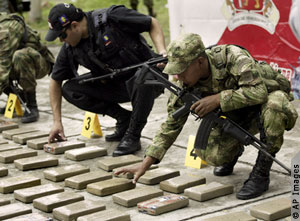
Dangerous Bedfellows in the Crime-Terrorism Nexus
The nature of asymmetric threats to U.S. security is changing, and so must our counteractive approach.
Convergence, the intersection of normally distinct types of illicit organizations, has become a growing concern in the global fight against terrorism—a concern Adm. James Stavridis has voiced well. Transnational criminal organizations (TCOs) and foreign terrorist organizations (FTOs) have approached a new or perhaps previously unrecognized level of interaction.

Heroine confiscated from convicted narco-terrorist and Taliban affiliate Haji Bagcho.
The collaboration between Dawood Ibrahim’s D-Company and Al-Qaeda for smuggling purposes is a telling example of this crime-terror fusion. The terrorist group Revolutionary Armed Forces of Colombia (FARC) has also engaged in narcotics trafficking and kidnapping for ransom—a technique favored by North Africa-based FTO Al-Qaeda in the Maghreb.
The latter examples illustrate an additional form of convergence where TCOs and FTOs begin to emulate the each other’s techniques, blurring the line between terrorism and criminal activity. Terrorism has always been in essence “criminal,” but the willingness of terrorists and criminal organizations to collaborate or expand their modus operandi opens up a dangerous array of possibilities.
Convergence represents immediate risks for obvious reasons, as it gives FTOs access to black-market financial and smuggling networks. However the long-term structural effects are equally threatening.
In the summary of a dialogue on the crime-terror pipeline hosted by the Department of State and Defense, Scott Helfstein of the Combating Terrorism Center at West Point outlines a very basic, yet destructive, supply and demand economic relationship between criminal organizations and terrorists.
Criminal organizations provide finances and materials to meet terrorist group demands, while FTOs simultaneously disrupt governments and provide the chaotic and destabilized environments in which criminal networks flourish. The two sides feed into each other, not in an ideological sense but operationally, working symbiotically to tear down the institutions that economies desperately need to grow.
Is convergence really as pressing a problem as some suggest, though?
Helfstein conducted an empirical study that certainly implies such. Highlighted in a recent Department of Defense report on transnational crime, his model examines the number of known linkages between individual persons of interests—terrorists, criminals, etc.
Beginning with 40 individuals, he worked outwards by two degrees, creating a web of connections totaling 2,739 people. Out of those nearly three thousand, only 53 were part of internal networks not connected to the larger web, and 46% of the terrorists examined were linked to non-terrorist activities.
This study doesn’t prove that terrorists and criminal organizations are necessarily collaborating or abandoning their original activities, but it does show that the connections and associations exist, regardless of whether or not these organizations have chosen to take advantage of them.
As global counter-terrorism and law enforcement efforts continue to constrict terrorist and criminal networks, continued convergence only seems a logical progression for the sake of their survival.
The U.S. must develop strategies to stay ahead of it.
What policy options does the U.S. have?
As Helfstein pointed out in his analysis, a majority of the connections were long, meaning that individuals were linked to one another through 10 to 14 people. The high number of lengthy connections means that the web has few hubs—powerful, highly-connected individuals holding much of the network together.
Therefore rather than targeting high-profile “kingpins,” as has been the traditional U.S. approach, attack the framework. Track suspicious financial behavior by connecting financial intelligence agencies across the globe, creating our very own transnational network. Conversely the international community must bolster counter-terrorism institutions within the African Union that disrupt illicit activities but suffer from corruption.
Inter-agency cooperation is also key. Gretchen Peters of George Mason University, in the same DoD report mentioned earlier, suggested “inter-agency teams” composed of military officials, diplomats, and other specialists to keep the focus on national security goals and not agency interests.
America’s longstanding War on Drugs and War on Terror have generated extensive strategies to accomplish their specific goals, and we need to capitalize on these resources. The fusion centers for sharing intelligence between local and federal levels that the Department of Homeland Security set up are important, but it should not stop there.
Cross-agency training must be a common practice, so that counter-terrorism agencies tracking cells can take advantage of the strategies that DEA agents use to monitor Mexican cartels.
Even illicit economies globalize, and U.S. national security policies need to adapt to the implications of a world-wide criminal network.






[…] Dangerous Bedfellows in the Crime-Terrorism Nexus […]
[…] prominence of AQIM and Boko Haram in the region demonstrates this trend, and the emergence of a new terror-crime nexus only exacerbates the […]